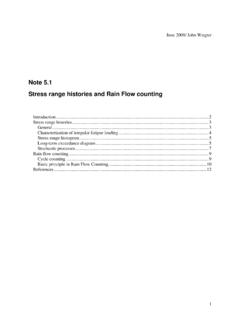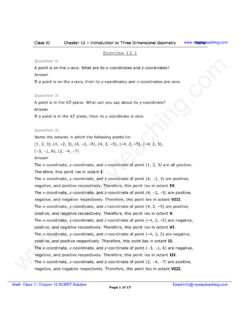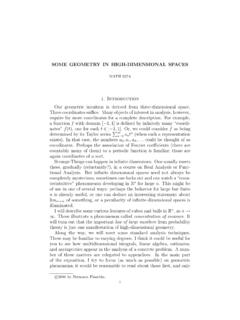Transcription of Elastic Beams in Three Dimensions - Aalborg Universitet
1 Elastic Beams in Three DimensionsLars Andersen and S ren NielsenISSN 1901-7286 DCE Lecture Notes No. 23 Department of Civil EngineeringAalborg UniversityDepartment of Civil EngineeringStructural MechanicsDCE Lecture Notes No. 23 Elastic Beams in Three DimensionsbyLars Andersen and S ren NielsenAugust 2008c Aalborg UniversityScientific Publications at the Department of Civil EngineeringTechnical Reportsare published for timely dissemination of research resultsand scientific workcarried out at the Department of Civil Engineering (DCE) at Aalborg University. This mediumallows publication of more detailed explanations and results than typically allowed in Memorandaare produced to enable the preliminary dissemination of scientific workby the personnel of the DCE where such release is deemed to be appropriate. Documents ofthis kind may be incomplete or temporary versions of papers or part of continuing work. Thisshould be kept in mind when references are given to publications of this Reportsare produced to report scientific work carried out under contract.
2 Publicationsof this kind contain confidential matter and are reserved forthe sponsors and the DCE. Therefore,Contract Reports are generally not available for public Notescontain material produced by the lecturers at the DCE for educational may be scientific notes, lecture books, example problems or manuals for laboratory work,or computer programs developed at the monograms or collections of papers published to report the scientific work carriedout at the DCE to obtain a degree as either PhD or Doctor of Technology. The thesis is publiclyavailable after the defence of the Newsis published to enable rapid communication of information about scientific workcarried out at the DCE. This includes the status of research projects, developments in the labora-tories, information about collaborative work and recent research 2008 byAalborg UniversityDepartment of Civil EngineeringSohngaardsholmsvej 57,DK-9000 Aalborg , DenmarkPrinted in Denmark at Aalborg UniversityISSN 1901-7286 DCE Lecture Notes No.
3 23 PrefaceThis textbook has been written for the course Statics IV on spatial Elastic beam structuresgiven at the 5th semester of the undergraduate programme in Civil Engineering at Aalborg Uni-versity. The book provides a theoretical basis for the understanding of the structural behaviourof Beams in Three - dimensional structures. In the course, the text is supplemented with labora-tory work and hands-on exercises in commercial structural finite-element programs as well asMATLAB. The course presumes basic knowledge of ordinary differential equations and struc-tural mechanics. A prior knowledge about plane frame structures is an advantage though notmandatory. The authors would like to thank Mrs. Solveig Hesselvang for typing the , August 2008 Lars Andersen and S ren Nielsen i iiDCE Lecture Notes No. 23 Contents1 Beams in Three .. of equilibrium for spatial Beams .. forces and stresses in a beam .. and deformations of a beam .. relations for an Elastic beam .
4 Equations of equilibrium for Beams .. equations for a Timoshenko beam .. equations for a Bernoulli-Euler beam .. of axial and bending deformations .. of the bending centre .. of the principal axes .. of equilibrium in principal axes coordinates .. stresses in Beams .. principle of virtual forces .. beam elements .. plane Timoshenko beam element .. Three - dimensional Timoshenko beam element .. 442 Shear stresses in Beams due to torsion and .. torsion (St. Venant torsion) .. assumptions .. of the homogeneous torsion problem .. torsion of open thin-walled cross-sections .. torsion of closed thin-walled cross-sections .. stresses from bending .. stresses in open thin-walled cross-sections .. of the shear centre .. stresses in closed thin-walled sections .. 91 References93 iii ivContentsDCE Lecture Notes No. 23 CHAPTER1 Beams in Three dimensionsThis chapter gives an introduction is given to Elastic beamsin Three Dimensions .
5 Firstly, theequations of equilibrium are presented and then the classical beam theories based on Bernoulli-Euler and Timoshenko beam kinematics are derived. The focusof the chapter is the flexural de-formations of Three - dimensional Beams and their coupling with axial deformations. Only a shortintroduction is given to torsional deformations, or twist,of Beams in Three Dimensions . A full de-scription of torsion and shear stresses is given in the next chapters. At the end of this chapter, astiffness matrix is formulated for a Three - dimensional Timosheko beam element. This element canbe used for finite-element analysis of Elastic spatial IntroductionIn what follows, the theory of Three - dimensional Beams is Equations of equilibrium for spatial beamsAn initially straight beam is considered. When the beam is free of external loads, the beamoccupies a so-called referential state. In the referentialstate the beam is cylindrical with thelengthl, cross-sections are everywhere identical.
6 The displacement and rotation of thebeam is described in a referential(x, y, z)-coordinate system with base unit vectors{i,j,k}, theoriginOplaced on the left end-section, and thex-axis parallel with the cylinder and orientatedinto the beam , see Fig. 1 1. For the time being, the position ofOand the orientation of they-andz-axes may be chosen beam is loaded by a distributed load per unit length of thereferential scale defined bythe vector fieldq=q(x)and a distributed moment load vector per unit lengthm=m(x). Adifferential beam element of the lengthdxis then loaded by the external force vectorqdxandexternal moment vectormdxas shown in Fig. 1 1. The length of the differential beam elementmay change during deformations due to axial strains. However, this does not affect the indicatedload vectors which have been defined per unit length of the referential state. Measured in the(x, y, z)-coordinate system,qandmhave the componentsq= qxqyqz ,m= mxmymz .(1 1) 1 2 Chapter 1 Beams in Three dimensionsijkxyzidxqdxmdxdxl MM+dM FF+dFFigure 1 1 beam in referential a consequence of the external loads, the beam is deformed into the so-called current statewhere the external loads are balanced by an internal sectionforce vectorF=F(x)and aninternal section moment vectorM=M(x).
7 These vectors act on the cross-section with the baseunit vectoriof thex-axis as outward directed normal vector. With reference to Fig. 1 2, thecomponents ofFandMin the(x, y, z)-coordinate system are:F= NQyQz ,M= MxMyMz (1 2)Here,N=N(x)is theaxial force, whereas the componentsQy=Qy(x)andQz=Qz(x)sig-nify theshear forcecomponents in they- andz-directions. The axial componentMx=Mx(x)ofthe section moment vector is denoted thetorsional moment. The componentsMy=My(x)andMz=Mz(x)in they- andz-directions represent thebending moments. The torsional momentis not included in two- dimensional beam theory. However, inthe design of Three -dimensionalframe structures, a good understanding of the torsional behaviour of Beams is that the displacements remain small, the equationof static equilibrium can beestablished in the referential state. With reference to Fig. 1 1, the left end-section of the elementis loaded with the section force vector Fand the section moment vector M. At the rightend-section, these vectors are changed differentially intoF+dFandM+dM, equilibrium and moment equilibrium formulated at thepoint of attack of the section forcevector Fat the left end-section then provides the following equations of force and momentDCE Lecture Notes No.
8 Equations of equilibrium for spatial beams3xyzMxMyMzNQyQzFigure 1 2 Components of the section force vector and the section moment of the differential beam element: F+F+dF+qdx=0 dFdx+q=0(1 3a) M+M+dM+idx (F+dF) +mdx=0 dMdx+i F+m=0(1 3b)From Eqs. (1 1) and (1 2) follows that Eqs. (1 3a) and (1 3b)are equivalent to the followingcomponent relations:dNdx+qx= 0,dQydx+qy= 0,dQzdx+qz= 0,(1 4a)dMxdx+mx= 0,dMydx Qz+my= 0,dMzdx+Qy+mz= 0.(1 4b)At the derivation of Eq. (1 4b), it has been utilised thati F=i (Ni+Qyj+Qzk) =Ni i+Qyi jQzi k= 0i Qzj+Qyk.(1 5)Hence,i Fhas the components{0, Qz, Qy}. It is noted that a non-zero normal-force compo-nent is achieved when the moment equilibrium equations are formulated in the deformed may lead to coupled lateral-flexural instability as discussed in a later Section forces and stresses in a beamOn the cross-section with the outward directed unit vector co-directional to thex-axis, the normalstress xxand the shear stresses xyand xzact as shown in Fig.
9 1 3. These stresses must beElastic Beams in Three Dimensions4 Chapter 1 Beams in Three dimensionsstatically equivalent to the components of the force vectorFand the section moment vectorMas indicated by the following relations:N=ZA xxdA,Qy=ZA xydA,Qz=ZA xzdA,(1 6a)Mx=ZA( xzy xyz)dA,My=ZAz xxdA,Mz= ZAy xxdA.(1 6b)xyzdAMxMyMzNQyQz xx xy xzFigure 1 3 Stresses and stress resultant on a cross-section of the xx yy zz xy yx xz zx yz zyFigure 1 4 Components of the stress sections orthogonal to they- andz-axes, the stresses{ yy, yx, yz}and{ zz, zx, zy}act as shown in Fig. 1 4. The first index indicates the coordinate axis co-directional to theoutward normal vector of the section, whereas the second index specifies the direction of actionof the stress component. The stresses shown in 4 form the components of the stress tensorDCE Lecture Notes No. Equations of equilibrium for spatial beams5 in the(x, y, z)-coordinate system given as = xx yx zx xy yy zy xz yz zz.
10 (1 7)Moment equilibrium of the cube shown in Fig. 1 4 requires that xy= yx, xz= zx, yz= zy.(1 8)Hence, is a symmetric Kinematics and deformations of a beamThe basic assumption in the classical beam theory is that a cross-section orthogonal to thex-axisat the coordinatexremains plane and keeps its shape during deformation. In other words, thecross-section translates and rotates as a rigid body. Especially, this means that Poisson contrac-tions in the transverse direction due to axial strains are ignored. Hence, the deformed positionof the cross-section is uniquely described by a position vectorw=w(x)and a rotation vector = (x)with the following components in the(x, y, z)-coordinate system:w= wxwywz , = x y z .(1 9)Further, only linear beam theory will be considered. This means that the displacement compo-nentswx, wyandwzin Eq. (1 9) all small compared to the beam lengthl. Further the rotationcomponents x, yand zare all small. Especially, this means thatsin tan ,(1 10)where represents any of the indicated rotation components measured in radians.










